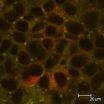(Press-News.org) BINGHAMTON, NY – Nanoparticles are everywhere. From cosmetics and clothes, to soda and snacks. But as versatile as they are, nanoparticles also have a downside, say researchers at Binghamton University and Cornell University in a recent paper published in the journal Nature Nanotechnology. These tiny particles, even in low doses, could have a big impact on our long-term health.
According to lead author of the article, Gretchen Mahler, assistant professor of bioengineering at Binghamton University, much of the existing research on the safety of nanoparticles has been on the direct health effects. But what Mahler, Michael L. Shuler of Cornell University and a team of researchers really wanted to know was what happens when someone gets constant exposure in small doses – the kind you'd get if you were taken a drug or supplement that included nanoparticles in some form.
"We thought that the best way to measure the more subtle effects of this kind of intake was to monitor the reaction of intestinal cells," said Mahler. "And we did this in two ways – in vitro, through human intestinal-lining cells that we had cultured in the lab; and in vivo, through the intestinal linings of live chickens. Both sets of results pointed to the same thing – that exposure to nanoparticles influences the absorption of nutrients into the bloodstream."
The uptake of iron, an essential nutrient, was of particular interest due to the way it is absorbed and processed through the intestines. The way Mahler and the team tested this was to use polystyrene nanoparticles because of its easily traceable fluorescent properties.
"What we found was that for brief exposures, iron absorption dropped by about 50 percent," said Mahler. "But when we extended that period of time, absorption actually increased by about 200 percent. It was very clear – nanoparticles definitely affects iron uptake and transport."
While acute oral exposure caused disruptions to intestinal iron transport, chronic exposure caused a remodeling of the intestinal villi – the tiny, finger-like projections that are vital to the intestine's ability to absorb nutrients – making them larger and broader, thus allowing iron to enter the bloodstream much faster.
"The intestinal cells are a gateway that ingested nanoparticles must go through to get to the body," said Mahler. "We monitored iron absorption both in vivo and in vitro and found that the polystyrene nanoparticles affected the absorption process and caused a physiological response."
The next step for Mahler and the team is to take a look at whether similar disruptions in nutrient absorption could be possible in other inorganic elements such as calcium, copper and zinc. Also on the research agenda is the reaction of other nutrients such as fat-soluble vitamins A, D, E and K. And chickens and their intestines will definitely be part of this next phase of the study.
"The gastrointestinal tract of chickens have very similar features to that of humans," said Mahler. "We can learn a great deal from the way chicken tissue works which means we can make better predictions about how humans will react."
And humans certainly consume enough nanoparticles – about 100 trillion of them every day. Their ultra-small size and amazing qualities makes them increasingly common in food and pharmaceutical products. Although the impact of chronic exposure remains somewhat unknown, the ingestion of dietary particles is thought to promote a range of diseases, including Crohn's disease. With so many nanomaterials under development and with so much yet to be learned about nanoparticle toxicity and potential human tissue reactivity, Mahler and the team are hoping that their work, particularly the in vitro model, will provide an effective low-cost screening tool.
INFORMATION:
Researchers show influence of nanoparticles on nutrient absorption
2012-03-12
ELSE PRESS RELEASES FROM THIS DATE:
OAI: Abuse of NY Auto Insurance System Highlighted by New Initiative
2012-03-12
A recent announcement from New York Gov. Andrew Cuomo saying that new capabilities would be granted to the state Department of Financial Services to help penalize medical care providers who abuse the state's no-fault system highlights the problems New York and other no-fault states have had keeping suspect claims out of those systems, according to OnlineAutoInsurance.com.
No-fault or personal injury protection (PIP) coverage was originally designed to be an affordable car insurance policy that got its cost savings from keeping car accident victims out of the court room. ...
Genetic manipulation boosts growth of brain cells linked to learning, enhances antidepressants
2012-03-12
DALLAS -- UT Southwestern Medical Center investigators have identified a genetic manipulation that increases the development of neurons in the brain during aging and enhances the effect of antidepressant drugs.
The research finds that deleting the Nf1 gene in mice results in long-lasting improvements in neurogenesis, which in turn makes those in the test group more sensitive to the effects of antidepressants.
"The significant implication of this work is that enhancing neurogenesis sensitizes mice to antidepressants – meaning they needed lower doses of the drugs to affect ...
JDRF-funded study shows roles of beta cells and the immune system in Type 1 diabetes
2012-03-12
New York, March 8, 2012 — A new JDRF-funded study shows that many of the genes known to play a role in type 1 diabetes (T1D) are expressed in pancreatic beta cells, suggesting that the cell responsible for producing insulin may be playing a part in its own destruction to lead to T1D. Published in the March issue of PLoS Genetics, researchers in Belgium suggest this interpretation after producing an extensive catalogue of more than 15,000 genes expressed in human islets, forming the most extensive characterization of human islets reported to date.
The researchers, ...
Effects of flooding on Cairo, Ill.
2012-03-12
URBANA – When faced with a choice between a deluge or a controlled deluge in May 2011 that would protect the city of Cairo, Illinois, the U.S. Army Corps of Engineers chose the latter by ordering an intentional breach of the Mississippi River levee at Bird's Point, but was it the right decision?
"The decision was a difficult and complex engineering problem with significant social and political trade-offs between loss of human lives and loss of properties in urban and rural areas," said University of Illinois researcher Ken Olson. "But it was a calculated risk built on ...
7-country study examining the causes of childhood pneumonia outlined
2012-03-12
(BALTIMORE, MD.) – The scientific journal Clinical Infectious Diseases has released its March Special Supplement focusing entirely on the research design of and pilot data from the Pneumonia Etiology Research for Child Health (PERCH) Project, which seeks to identify the causes of pneumonia among the world's most vulnerable populations. PERCH, led by the International Vaccine Access Center (IVAC) at the Johns Hopkins Bloomberg School of Public Health in collaboration with 7 research centers worldwide, is the largest and most comprehensive study of the etiology of childhood ...
Sport fields: Catalysts for physical activity in the neighborhood?
2012-03-12
If you're a woman, older adult, or have higher levels of education, you're less likely to be sufficiently physically active. Those are some of the findings of a new University of Alberta study examining people's actual and perceived access to sport fields as catalysts for physical activity.
"We know there are many studies indicating that the actual or perceived access to facilities is associated with physical activity, but it is not clear whether the perceived environment or objective environment exert stronger influences on physical activity," says study author Nicoleta ...
Nanotube technology leading to new era of fast, lower-cost medical diagnostics
2012-03-12
CORVALLIS, Ore. – Researchers at Oregon State University have tapped into the extraordinary power of carbon "nanotubes" to increase the speed of biological sensors, a technology that might one day allow a doctor to routinely perform lab tests in minutes, speeding diagnosis and treatment while reducing costs.
The new findings have almost tripled the speed of prototype nano-biosensors, and should find applications not only in medicine but in toxicology, environmental monitoring, new drug development and other fields.
The research was just reported in Lab on a Chip, a ...
An insight into human evolution from the gorilla genome sequence
2012-03-12
Researchers announce today that they have completed the genome sequence for the gorilla, the last genus of the living great apes to have its genome decoded. While confirming that mankind's closest relative is the chimpanzee, the team shows that much of the human genome more closely resembles the gorilla than it does the chimpanzee genome. This is the first time scientists have been able to compare the genomes of all four living great apes: humans, chimpanzees, gorillas and orangutans. This study provides a unique perspective on human origins and is an important resource ...
Brain cancer blood vessels not substantially tumor-derived, Johns Hopkins scientists report
2012-03-12
Johns Hopkins scientists have published laboratory data refuting studies that suggest blood vessels that form within brain cancers are largely made up of cancer cells. The theory of cancer-based blood vessels calls into question the use and value of anticancer drugs that target these blood vessels, including bevacizumab (Avastin).
"We don't question whether brain cancer cells have the potential to express blood vessel markers and may occasionally find their way into blood vessels, but we do question the extent to which this happens," says Charles Eberhart, M.D., Ph.D., ...
Evidence-based systems needed to reduce unnecessary imaging tests
2012-03-12
Philadelphia, PA, March 9, 2012 – Imaging has been identified as one of the key drivers of increased healthcare costs. A new study from Brigham and Women's Hospital and Harvard Medical School has found significant variation in the use of head computed tomography (CT), even within a single emergency department. Strategies to reduce such variation in head CT use may reduce cost and improve quality of care. The study appears online in advance of publication in the April issue of The American Journal of Medicine.
A recent measure approved by the Centers for Medicare and ...


